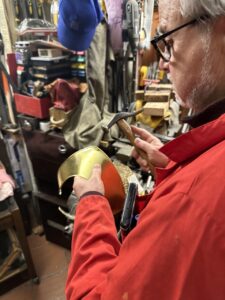THE MASTER OF THE ART
Continues from part 2
ADDITIONAL ROLES
There are different roles involved in a classic Opera dei Pupi performance, some more central than others, but these are without a doubt the cardinal figures of the performance: I manianti (the puppeteers) on one side, and o parraturi (the person who gives the voice to the pupi and plays the drum) on the other, who in Catania (but not in Palermo) is accompanied by a parratrice for the female characters. However, there is another important figure who is at the core of this universe: the puparo.

Nowadays, there are people that are self-proclaimed “pupari”, because they own some pupi or they are the producer and/or manager of the show. However, those in the sector recognize that the puparo is actually the highly skilled artisan who creates the puppets, literally from scratch, and only he should be considered a puparo.

THE CENTER OF THE UNIVERSE
The puparo, as a role, was born by uniting the skills and the ancient arts of ten or more artisans into one person including carpenter, blacksmith, painter, welder, sculptor, designer, and tailor. Creating a pupo starts from a piece of plain, uncarved wood, all the way through to the last string attached to the shield. The story goes that it was Giovanni Grasso, from Acireale, who in 1860 invented the two metal rods for maneuvering the puppets, which we mentioned earlier. He was also the one who brought together the ten artisans and combined their work into a single, magnificent piece of art. Thanks to the work of the puparo, combined with the mastery of puppeteers, every time a pupo steps onto the stage, it is no longer a piece of wood, but comes alive.

This also happens because the pupo is almost “a son” to the puparo himself, as the master artisans we visited in Catania told us many times. Considering the uncountable hours of creative work, and the considerable economic investment that the master has put into it—not that he has ever complained nor economized in the making process, on the contrary—it is easy to accept that as a fact.


Moreover, there is the knowledge and the responsibility of the emotional investment that the audience will put into that “object” when it performs, and the relationship that he builds with them. But that is another story.
THE REAL CRISIS
Many things have changed over the years and many adjustments have been necessary for the art to endure the various crises and survive into modernity. The Opr’e Pupi is still alive, although it is on the edge of a dangerous “cliff”, with the risk of falling and getting lost in the depths of the ocean below at any moment.

Tourism is a great opportunity to keep this art alive, as long as it is done in harmony with the local culture and respects the real traditions and old stories.
The biggest crisis, however, must be addressed locally; new generations must somehow be reconnected to it because there are no daily shows anymore. Sometimes the real stories and values have been diluted, as reflected in some more touristic presentations and scripts. Passing on the passion for this art is a duty as well as a joy for the small bunch of artisans who are still expressing their love for it every day.

We hope to see new fixed theaters, dedicated to the Opera dei Pupi, opened and supported in Catania so that some of those sparkles can fill the hearts of youngsters and be taken forward into the next generation.
We cannot wait to help you experience a traditional show and meet the local pupari and other artists, who continue making the magic happen by creating lively “masks” that are more a mirror than a cover.

Words and pictures by Elisa Spampinato


